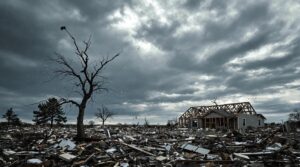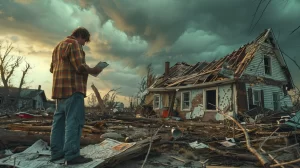Essential tornado safety requires understanding alert differences between watches and warnings, plus recognizing warning signs like rotating clouds and dark skies. Having a designated safe room on the lowest floor, away from windows, provides vital protection. Families should maintain emergency kits with water, food, and communication devices while establishing clear evacuation plans and meeting locations. Proper preparation and immediate action during tornado emergencies greatly increase survival chances, with additional measures offering enhanced protection.
Key Takeaways
- Seek immediate shelter in a basement or interior room on the lowest floor, away from windows and exterior walls.
- Monitor local weather updates and official warnings through a NOAA weather radio or emergency alert system.
- Keep an emergency kit with water, non-perishable food, medications, batteries, and important documents in your designated safe room.
- If caught outside, lie flat in a low spot or ditch, protecting your head with your arms from flying debris.
- Create barriers using heavy furniture and thick blankets to protect against debris, and use helmets for additional head protection.
Know the Difference Between Tornado Watches and Warnings
Two vital weather alerts that everyone should understand are tornado watches and tornado warnings.
These distinct alerts serve different purposes in tornado safety and emergency preparedness. A tornado watch, issued by the Storm Prediction Center, indicates favorable conditions for severe weather across large geographical areas and typically remains active for several hours. During a watch, individuals should review emergency plans, secure outdoor items, and monitor weather updates.
A tornado warning, in contrast, signals immediate danger and requires swift action. Local National Weather Service meteorologists issue these warnings for specific areas when a tornado has been spotted or detected by radar.
These warnings usually last 30-60 minutes and demand immediate shelter in an interior room on the lowest floor of a sturdy building. Understanding this difference is essential: watches call for preparation and vigilance, while warnings require immediate protective action to guarantee survival.
Create a Family Emergency Plan
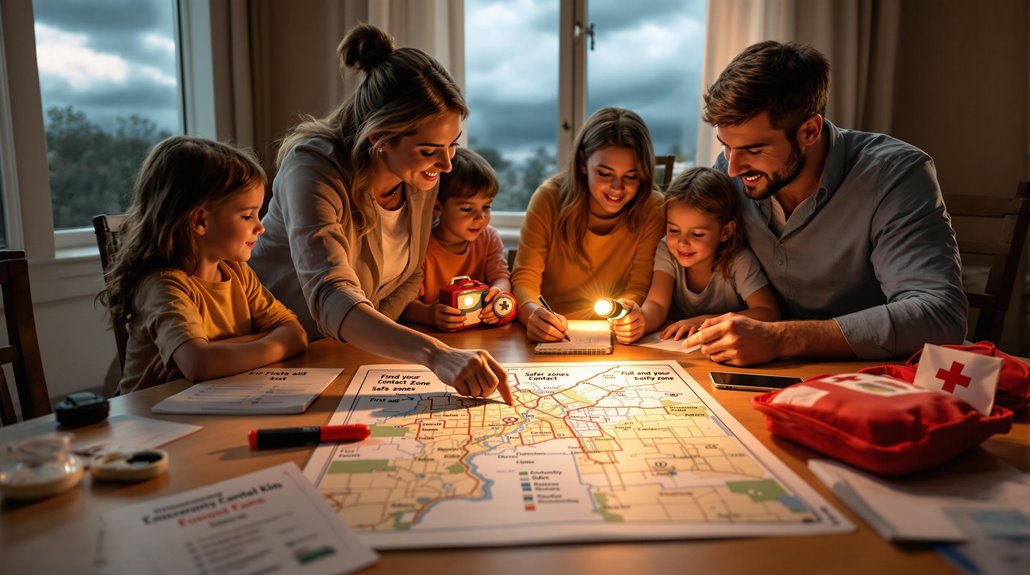
A thorough family emergency plan requires establishing a clear communication chain that specifies how family members will contact each other during and after a tornado.
Families should designate both local and out-of-state contacts who can relay messages between separated family members when local communications may be disrupted.
The plan must include specific meeting locations, with one point near the home for immediate gathering and another location outside the neighborhood in case the primary area is inaccessible.
Communication Chain Setup
Creating an effective communication chain represents a critical foundation of any family's tornado preparedness plan. A thorough system integrates multiple communication tools, including emergency contact lists, ICE numbers in mobile devices, and family contact sheets with critical information for all household members.
Proper disaster preparedness requires establishing both local and out-of-town contacts who can serve as central points of communication during emergencies.
Families should develop a clear protocol that specifies when to use text messages versus voice calls, recognizing that texts often penetrate network congestion more effectively during disasters. The plan should account for household-specific needs, including children's schools, language considerations, and provisions for family members with disabilities.
Registration with local emergency alert services guarantees timely access to critical updates and warnings.
Meeting Points After Storm
Establishing multiple meeting points forms the cornerstone of an effective family emergency plan for tornado scenarios. Families should designate specific post-storm gathering locations at multiple distances from their residence, ensuring all members can reunite safely regardless of their location during the event.
| Location Type | Purpose |
|---|---|
| Indoor Safe Room | Primary shelter during tornado |
| Neighborhood Point | Immediate post-storm assembly |
| Community Location | Secondary meeting option |
| Out-of-Area Site | Backup gathering point |
| Emergency Contact | Remote coordination hub |
A thorough plan includes sharing these designated points with all family members and posting them in accessible locations. Each person should carry written emergency contact information and understand the hierarchy of meeting locations, from closest to farthest, enabling systematic reunification after the tornado passes.
Identify Your Safe Room or Storm Shelter
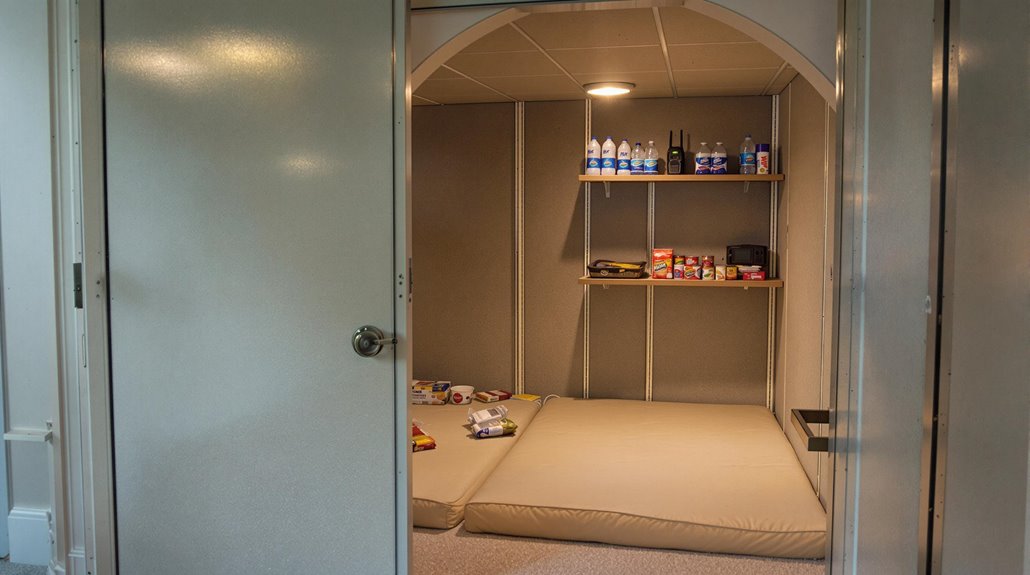
Identifying a safe room or storm shelter before severe weather strikes can mean the difference between life and death during a tornado.
The most effective safe room locations are on the lowest level of a building, away from windows and exterior doors. Interior room choices should prioritize small, enclosed spaces such as bathrooms or closets, which offer additional structural support due to plumbing or reinforced walls.
For maximum protection during a tornado, consider these critical factors:
- Select a room in the basement or lowest floor, preferably without windows or external walls
- Choose interior spaces that are reinforced or strengthened by surrounding structure
- Confirm the location is easily accessible and stocked with emergency supplies
In apartment buildings or public spaces, identify interior hallways or stairwells away from windows as alternative shelter locations.
Mobile homes provide no safe shelter during tornadoes, making it essential to locate nearby community shelters or sturdy buildings for emergency use.
Recognize the Warning Signs of a Tornado
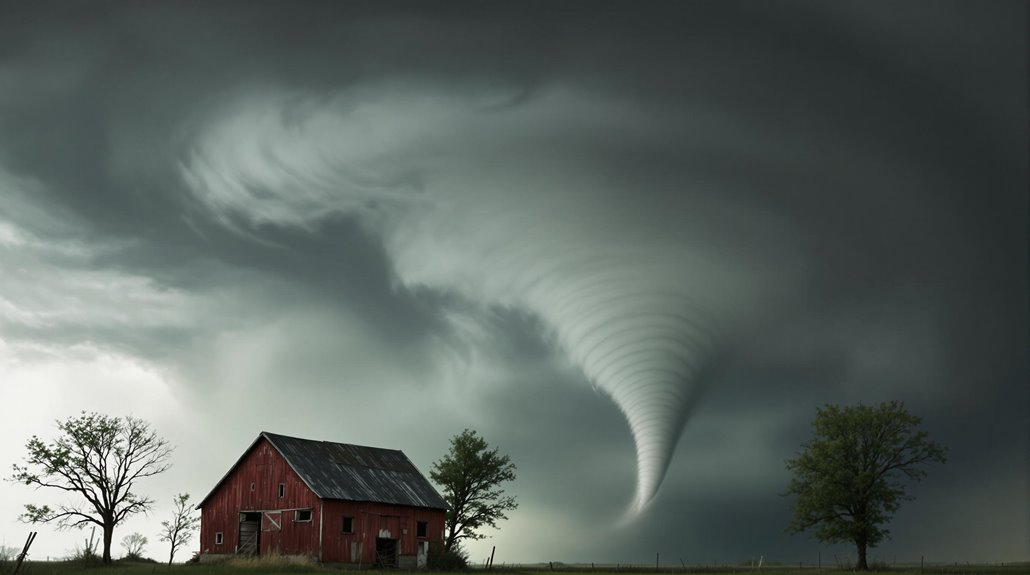
Successful tornado survival depends on recognizing the warning signs before the storm strikes. Modern tornado prediction techniques and weather radar analysis provide valuable advance warnings, but understanding natural indicators remains essential for personal safety.
Visual signs often provide the first indication of an impending tornado. These include rotating funnel-shaped clouds, dark or greenish skies, and approaching debris clouds near the ground. Large hail frequently precedes tornado formation. The distinctive sound of an approaching tornado, often described as similar to a freight train, serves as a vital auditory warning sign.
Environmental conditions that signal potential tornado development include severe thunderstorms, sudden temperature drops, and significant increases in humidity and wind speed.
Official alerts are categorized as either Tornado Watches or Warnings, with the latter requiring immediate action. Monitoring NOAA Weather Radio, local news updates, and emergency mobile alerts provides essential real-time information about developing tornado threats.
Essential Items for Your Tornado Emergency Kit

After recognizing tornado warning signs, preparation through a well-stocked emergency kit becomes the next line of defense. A thorough tornado preparedness checklist should include emergency kit essentials organized into distinct categories for quick access during critical situations.
Key emergency kit components must include:
- Basic survival supplies: one gallon of water per person daily for three days, nonperishable food, NOAA weather radio, flashlights, and a complete first-aid kit.
- Personal care items: prescription medications, dust masks, hygiene supplies, and protective gear including blankets and sleeping bags.
- Communication tools and documents: charged cell phones, portable chargers, local maps, and waterproof storage containing essential documents like insurance policies and identification.
Additional considerations include maintaining supplies for special needs, such as infant care items or pet supplies, and regularly checking expiration dates on food, medications, and batteries to verify all items remain viable for emergency use.
Best Places to Take Shelter During a Tornado
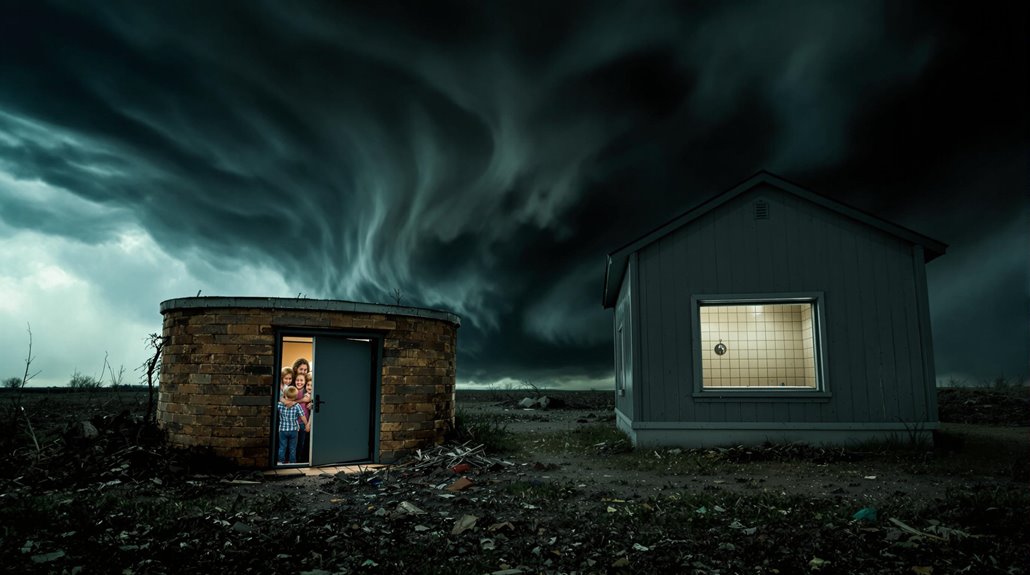
During a tornado, individuals should prioritize seeking shelter in the interior part of a basement or, if unavailable, a windowless room on the lowest floor of a building.
Ideal protection within these locations involves positioning oneself under sturdy furniture like a heavy table while using blankets or mattresses as additional covering.
When caught outside with no building access, the safest option is to lie flat in a low spot such as a ditch or ravine while protecting the head with hands.
Indoor Shelter Priorities
The most critical decision during a tornado threat involves identifying and reaching the safest available shelter location. Indoor safety measures prioritize basement locations when available, as these provide ideal protection from the storm's destructive forces.
When evaluating storm shelter considerations, individuals should select spaces that maximize structural protection while minimizing exposure to potential hazards.
Key shelter priorities in order of effectiveness:
- Basements or storm cellars, positioning away from heavy overhead objects and utilizing sturdy furniture for additional protection
- Interior rooms on the lowest floor without windows, such as bathrooms, closets, or hallways, staying central to avoid debris accumulation in corners
- Specially designed safe rooms or reinforced areas that meet FEMA standards for tornado resistance
Mobile homes should be evacuated immediately in favor of sturdy permanent structures, regardless of tie-down systems.
Outside Without Building Access
Life-threatening situations demand swift action when individuals find themselves outdoors during a tornado with no buildings nearby for shelter. Among critical tornado preparedness tips, experts recommend lying flat and face-down on low ground, preferably in ditches or ravines, while protecting the head from flying debris.
| Emergency Response Strategies | Safety Actions |
|---|---|
| Ground Position | Lie flat, face-down on lowest ground |
| Head Protection | Cover with hands or objects |
| Location Selection | Seek ditches or ravines |
Key safety considerations include avoiding vehicles and highway overpasses, which provide inadequate protection. While outdoors, stay alert for additional hazards such as flash flooding and falling trees. Monitor weather conditions via battery-powered radios and remain aware of changing circumstances until the threat passes.
What to Do if You're Caught Outside
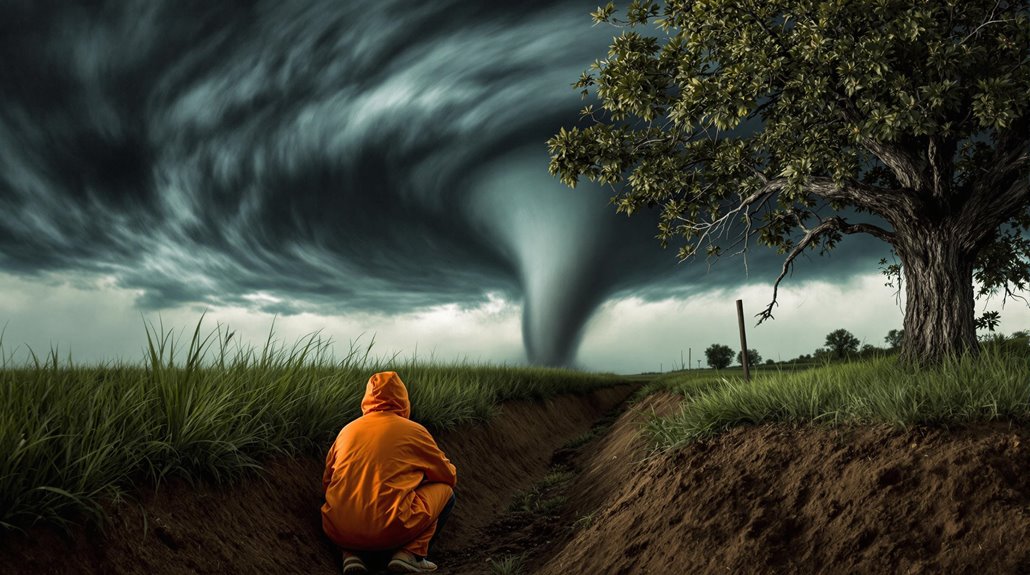
When caught outdoors during a tornado, individuals must act quickly to find adequate shelter or implement emergency safety measures. Understanding outdoor hazards and proper emergency signaling can considerably increase survival chances during these extreme weather events.
If no sturdy building is accessible, people should avoid seeking shelter near trees, vehicles, or under bridges. Instead, they should locate the lowest possible ground, such as a ditch or gully, and lie flat face-down while protecting their head.
Essential actions for those caught outside during a tornado:
- Move immediately to low ground if no sturdy building is nearby.
- Position body face-down and use arms or an object to protect the back of the head.
- Stay away from potential hazards such as trees, vehicles, and bridges that can create dangerous wind tunnels.
For those in vehicles, parking safely and staying belted while keeping below window level offers temporary protection until better shelter becomes available.
Protect Yourself From Flying Debris
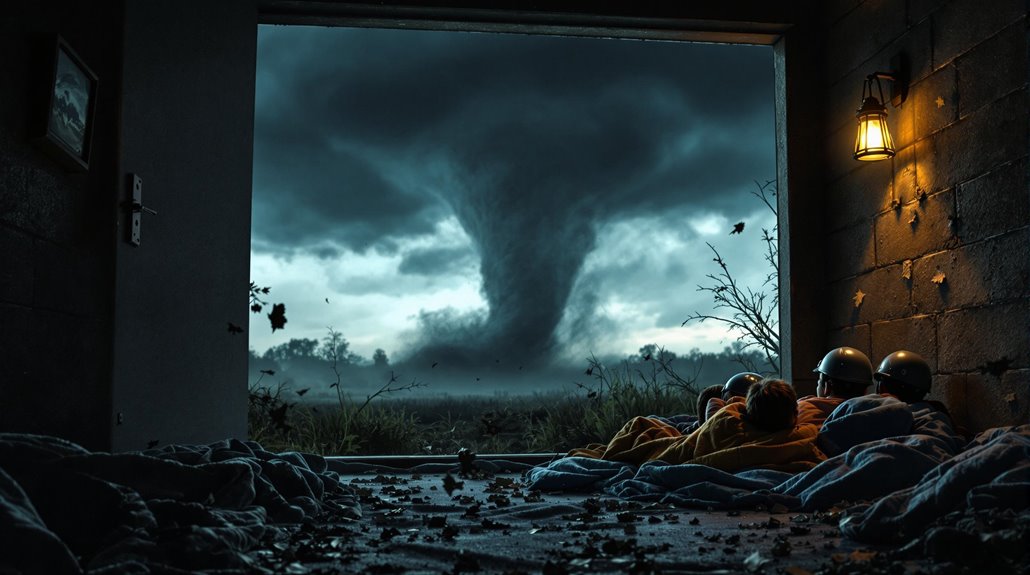
Flying debris poses one of the most significant risks during a tornado, making immediate head and neck protection essential for survival.
When caught in a tornado's path, individuals should quickly seek sturdy indoor shelter, preferably in a basement or interior room away from windows.
Creating protective barriers with heavy furniture, mattresses, or blankets provides an additional layer of defense against dangerous airborne objects.
Cover Head and Neck
During a tornado's destructive path, debris becomes the most lethal threat to human safety, responsible for numerous injuries and fatalities.
Protecting the head and neck requires specific covering techniques and appropriate helmet options. Research validates that any helmet designed for head protection can markedly reduce injury from high-velocity impacts, with full-sized motorcycle racing helmets offering peak protection.
Essential protective measures include:
- Lying face-down while using arms to shield the head and neck
- Utilizing blankets, mattresses, or pillows as protective covering when mobility is limited
- Positioning beneath sturdy furniture like heavy tables or workbenches for additional protection
Helmets should be stored in easily accessible locations throughout homes, vehicles, and workplaces as part of thorough tornado preparedness, though they do not substitute for proper shelter in a windowless, ground-level room.
Find Indoor Protection Fast
In the critical moments before a tornado strikes, rapid identification of safe indoor shelter locations becomes paramount for survival. Key tornado preparedness tips emphasize seeking protection in basements or interior rooms on the lowest floor. Indoor safety strategies should focus on selecting spaces away from windows and areas free from overhead heavy objects.
| Location Type | Primary Safety Features | Secondary Features | Risk Level |
|---|---|---|---|
| Basement | Underground protection | Interior corner best | Lowest |
| Interior Room | No windows | Solid walls | Low |
| Bathroom | Small space | Plumbing reinforcement | Moderate |
| Hallway | Multiple access points | Central location | Moderate-Low |
FEMA-compliant shelters provide ideal protection through specific construction requirements, including impact-resistant materials and secure anchoring. Communities often designate public storm shelters that meet these rigorous standards, making them reliable options during severe weather events.
Create Debris Safety Barriers
When tornadoes threaten indoor spaces, properly constructed debris barriers become an essential component of personal protection.
Creating effective debris shields requires strategic placement of sturdy furniture and protective coverings to minimize exposure to flying objects. Occupants should utilize heavy tables, mattresses, and blankets to establish protective barriers, particularly around windows and vulnerable areas.
Key steps for creating debris protection include:
- Position heavy furniture against windows and exterior walls to serve as primary debris shields
- Cover windows with thick blankets or mattresses to reduce the impact of airborne objects
- Establish multiple layers of protection by combining furniture barriers with protective coverings
These protective measures, when properly implemented, greatly enhance safety by reducing the risk of injury from wind-driven debris during a tornado event.
Stay Connected With Emergency Updates
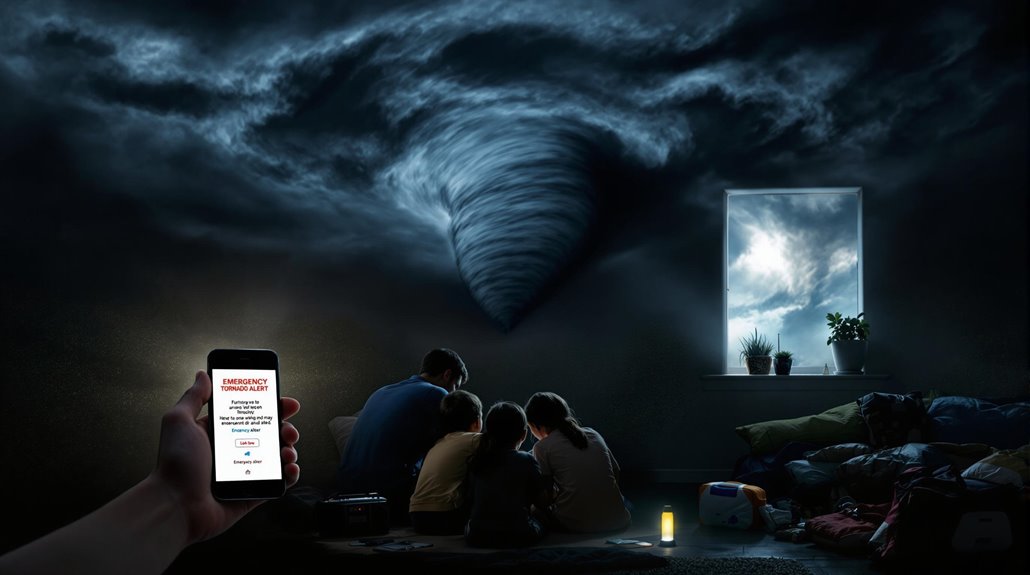
Staying connected with emergency alerts and updates serves as a crucial lifeline during tornado threats. Modern communication technology enables multiple channels for receiving essential weather information through integrated mass notification systems. Emergency notifications delivered through IPAWS reach both residents and travelers via regional broadcasts, digital signage, and wireless devices.
| Alert Type | Action Required |
|---|---|
| Tornado Watch | Monitor conditions, review emergency plans |
| Tornado Warning | Seek immediate shelter, follow instructions |
| Weather Radio | Keep powered and within hearing range |
| Mobile Alerts | Enable WEA notifications on devices |
For maximum safety, individuals should configure their devices to receive automated alerts through multiple channels, including weather radios, mobile phones, and email. Local forecast offices issue time-sensitive warnings while providing real-time updates on tornado conditions. These systems deliver clear, actionable instructions with links to essential resources, including shelter locations and evacuation routes. After the immediate threat passes, these same channels communicate all-clear signals and crucial recovery information.
Post-Storm Safety and Recovery Steps
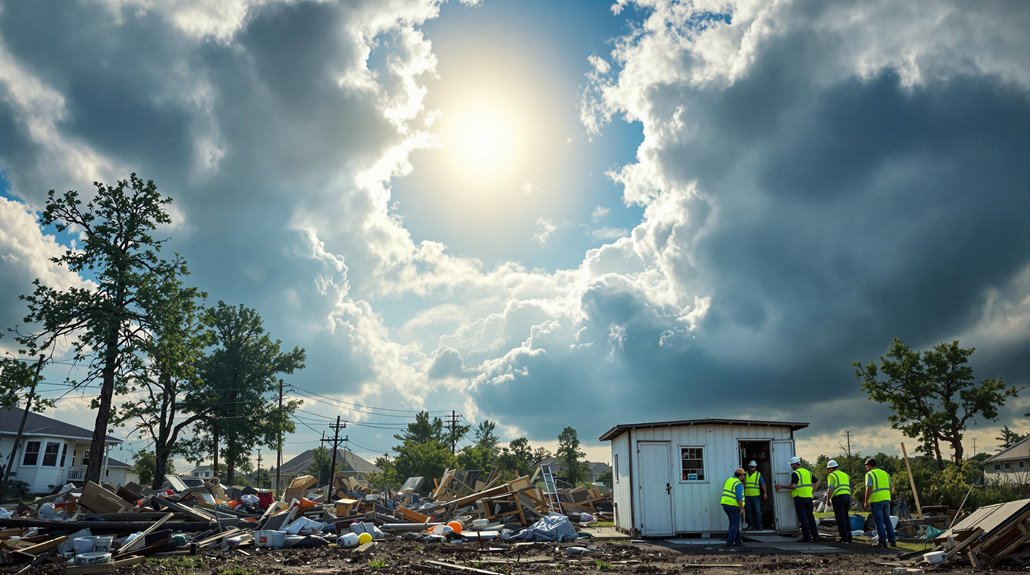
Ensuring safety during the critical post-tornado period requires methodical steps and careful attention to potential hazards. Initial actions should focus on addressing immediate medical needs, evaluating structural damage, and documenting losses for insurance purposes. Emergency kit essentials become essential during this phase, especially when treating minor injuries or providing basic first aid. Additionally, it is crucial to establish communication with local authorities and emergency services to stay informed about available resources and assistance. When assessing the situation, individuals must be vigilant about the possible presence of hazards such as downed power lines and unstable structures that can pose risks. The aftermath of such an event, particularly in the case of ef5 tornado damage and effects, can leave communities in dire need of support and recovery efforts, making it vital to work collaboratively with neighbors and local organizations to aid in the rebuilding process.
- Conduct thorough safety inspections before entering damaged structures
- Document all damage with photographs and detailed notes
- Contact insurance providers and register for tornado recovery resources
Professional evaluation of structural integrity remains paramount before re-entering damaged buildings. Victims should exercise extreme caution around debris fields, watching for exposed nails, broken glass, and compromised power lines.
Those affected should maintain contact with emergency services and monitor official communications for ongoing safety advisories. When beginning cleanup operations, individuals should work systematically, focusing first on preventing additional property damage through temporary repairs while awaiting professional restoration services.
The Benefits Of Consulting A Public Adjuster

Public adjusters provide professional expertise in steering complex insurance claims following tornado damage, offering objective assessments that guarantee all damages are properly documented and valued.
Their specialized knowledge of insurance policies and claims processes helps streamline the settlement process while advocating exclusively for the policyholder's interests.
Statistical evidence indicates that policyholders who engage public adjusters typically receive markedly higher claim settlements compared to those who handle claims independently.
For maximum effectiveness, early adjuster involvement is crucial to thoroughly document all tornado-related losses and prevent potential claim complications.
Expertise In Insurance Claims
After experiencing tornado damage, consulting a public adjuster can considerably improve the insurance claims process and potential settlement outcomes.
These licensed professionals possess extensive knowledge of insurance policies, procedures, and industry regulations, enabling them to navigate complex claims effectively.
Key advantages of public adjuster expertise include:
- Thorough documentation and assessment of tornado damage, ensuring all losses are properly identified and valued.
- Strategic management of insurance negotiations, leveraging their understanding of company tactics to maximize settlements.
- Expert interpretation of policy terms and conditions, helping secure all entitled benefits under the coverage.
Their professional expertise allows property owners to focus on recovery while the adjuster handles claim documentation, damage evaluation, and settlement negotiations.
This specialized knowledge often results in more favorable claim resolutions and proper compensation for tornado-related damages.
Effective communication between adjusters, contractors, and homeowners significantly enhances the likelihood of a successful insurance claim.
Objective Damage Assessment
When faced with tornado damage, an objective assessment conducted by a public adjuster provides property owners with an extensive and unbiased evaluation of their losses.
These professionals employ systematic damage evaluation methods to identify both visible and concealed structural issues that property owners might overlook.
Public adjusters compile detailed documentation of all damages, supporting their findings with detailed reports and expert analysis.
Their specialized knowledge in insurance negotiation enables them to communicate effectively with insurance companies, often securing higher settlements than initial offers.
Studies demonstrate that properties assessed by public adjusters frequently receive more substantial compensation due to their detailed documentation and professional representation.
Unlike insurance adjusters who prioritize company interests, public adjuster fees are commission-based, typically up to 10% of the final settlement, ensuring their dedication to maximizing client compensation.
Streamlined Claim Process
Three core benefits emerge when engaging a public adjuster during the tornado insurance claims process: expert representation, expedited settlements, and detailed support throughout the proceedings.
Public adjusters streamline claims documentation by managing all communications and paperwork with insurance companies, while conducting thorough benefits analysis to maximize settlement outcomes.
Key advantages of professional claims management include:
- Efficient coordination of property inspections, damage assessment documentation, and required evidence gathering
- Expert negotiation capabilities that frequently result in higher settlement offers
- Extensive oversight of the entire claims lifecycle, ensuring adherence to policy terms and deadlines
This systematic approach reduces processing time, minimizes errors, and allows policyholders to focus on recovery while experienced professionals handle the complex aspects of their insurance claim.
With commission rates typically ranging from 5% to 15% of the final settlement, public adjusters deliver value through their specialized expertise and proven track record of securing favorable outcomes.
Higher Claim Payouts & Settlements
Engaging a public adjuster for tornado damage claims consistently leads to higher settlement amounts compared to self-filed claims. Through expert claim negotiation strategies and detailed damage assessment protocols, public adjusters maximize settlement opportunities by documenting all losses meticulously.
| Settlement Factor | Impact on Claims |
|---|---|
| Expert Evaluation | Thorough documentation of all damages |
| Industry Knowledge | Strategic policy interpretation |
| Negotiation Skills | Enhanced settlement leverage |
| Objective Assessment | Elimination of emotional factors |
| Professional Advocacy | Protection of policyholder interests |
Public adjusters typically charge 10% of the settlement amount, operating on a contingency basis that aligns their interests with policyholders. Their specialized expertise in complex claims scenarios, combined with their understanding of insurance policy intricacies, guarantees thorough coverage of all legitimate damages, resulting in markedly higher claim settlements. Independent repair estimates provide competitive figures that strengthen your negotiating position when working with insurance adjusters.
About The Public Claims Adjusters Network (PCAN)

Although tornado safety is the primary focus of this article, it is important to note that insurance claims often follow in the aftermath of these devastating storms. The Public Claims Adjusters Network (PCAN) serves as a professional association dedicated to promoting ethical practices and consumer advocacy in the insurance claims industry.
PCAN members assist policyholders in guiding through complex insurance claims processes while adhering to strict public adjuster ethics standards.
Key services provided by PCAN members include:
- Extensive damage assessment and detailed documentation of losses
- Expert policy interpretation and claims preparation
- Professional negotiation with insurance companies to maximize claim settlements
PCAN's commitment to consumer protection extends through various resources and educational initiatives. The organization provides ongoing training for public adjusters while maintaining rigorous professional standards.
Through their expertise, PCAN members help guarantee policyholders receive fair treatment and appropriate compensation during the challenging post-disaster recovery period.
Frequently Asked Questions
How Long Do Most Tornadoes Last Before Dissipating?
Most tornadoes exhibit brief tornado duration, typically lasting less than 10 minutes, with two-thirds being lower tornado intensity EF-0 or EF-1 storms that dissipate after traveling approximately 3.5 miles.
Can Tornadoes Occur at Night While People Are Sleeping?
When darkness falls, danger calls. Night tornadoes occur frequently, comprising 27.3% of all tornado events and posing heightened risks to sleeping populations, making proper sleeping preparedness essential for survival.
What's the Average Time Between Tornado Warning and Actual Touchdown?
Modern tornado detection technology provides an average warning timeframe of 11 minutes between initial warning and tornado touchdown, though this duration varies markedly based on atmospheric conditions and radar capabilities.
Do Tornadoes Always Move From Southwest to Northeast?
While storm tracking data shows most tornadoes follow southwest-to-northeast patterns, significant variations exist. Some destructive tornadoes move northwest-to-southeast, and local weather conditions can alter these traditional movement patterns.
Can Pets Sense an Approaching Tornado Before Humans Can?
Research indicates animals can detect approaching tornadoes through enhanced sensory capabilities, including barometric pressure changes and low-frequency sound detection, often exhibiting distinctive storm detection behaviors before humans perceive danger.
References
- https://www.lonestarsaferooms.com/10-tornado-safety-tips/
- https://www.belfor.com/us/en/resources/signs-of-a-tornado/
- https://www.weather.gov/safety/tornado-ww
- https://www.cdc.gov/tornadoes/safety/stay-safe-during-a-tornado-safety.html
- https://police.mercer.edu/safety-resources/severe-weather-procedures/tornado-safety-measures/
- https://www.vercounty.org/news-item/tornado-watches-vs-warnings/
- https://abc7.com/tornado-warning-severe-weather-alerts-watch-vs-accuweather/5321358/
- https://www.tdi.texas.gov/blog/tornado-watch-vs-warning.html
- https://abc11.com/tornado-thunderstorm-watch-warning-heres-difference-what-do-when-see-alert-messages-severe-weather-warnings/13428746/
- https://www.kansastag.gov/385/Tornado-Safety-for-Citizens
